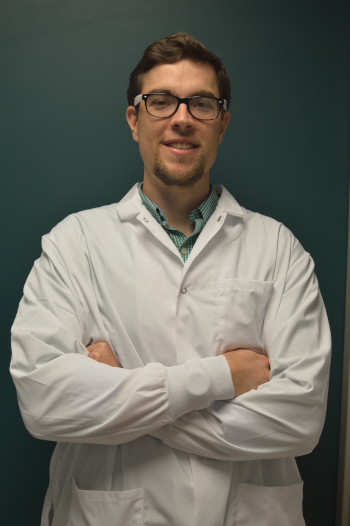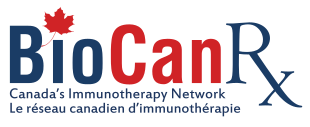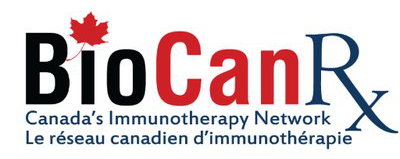By Heather Blumenthal
 Llamas have served the people of the Andes mountains in South America for centuries, as pack animals and sources of fibre and food. Today, llamas are also being put to work here in Canada, to help develop novel forms of antibodies that can then be used for CAR T therapy.
Llamas have served the people of the Andes mountains in South America for centuries, as pack animals and sources of fibre and food. Today, llamas are also being put to work here in Canada, to help develop novel forms of antibodies that can then be used for CAR T therapy.
Dr. Scott McComb of the National Research Council of Canada (NRC) and the University of Ottawa Department of Biochemistry Microbiology and Immunology, is leading a BioCanRx-supported Enabling Project, titled Clinical Trial Enabling Studies for Multi-targeted Chimeric Antigen Receptor.
What he and his team are doing with llama antibodies could dramatically improve the success of CAR T therapies by ensuring a greater likelihood of the patient responding to treatment and of that response lasting much longer – ideally, Dr. McComb says, for a lifetime.
Dr. McComb explains that current CAR T therapies approved for use in the clinic, are very successful for some people. Others, however, do not respond well to treatment. And even for those with a good response, that response can weaken over time. The reason? Cancer cells are smart. When they sense that the CAR T molecules are attaching to antigens on their surface, short-circuiting their ability to repel immune system attacks, cancer cells can stop showing that antigen (much the way the virus that causes Covid-19 can mutate by changing the spike proteins on its outside). Now, the CAR T therapy is of no use because it attaches to one antigen only and that antigen is no longer there, and the patient will suffer a relapse. This happens in about one-third of cases.
Currently, all the CAR T molecules that are commercially available to treat B cell leukemia and lymphoma target the same antigen, CD19. Dr. McComb and his team are working to develop a CAR T molecule that attaches to multiple antigen targets (CD19, but also CD20 and CD22) that are commonly found on B-cell leukemia cells. The idea is that one CAR T molecule can be used in more patients, because it will be effective against more kinds of cancer cells, and when the cancer cell changes to a different antigen, the CAR T molecule will still be effective. The onus will be on the cancer cell to “evolve more radically,” says Dr. McComb.
“By targeting more than one target, we’re hoping to get a response not just in the short term but one that lasts,” he says.
The vital first step to this research is to create antibodies that will bind tightly to different CD proteins on the outside of the cancer cell. These antibodies develop when a vaccine is injected into animals that elicits a strong antibody response against them. To find a new antibody that specifically attaches to only one CD protein requires its own engineered vaccine. So to find antibodies that attach to several CD proteins requires several such vaccines.
That’s where the llamas come in.
While most other antibody-finding studies usually use mice, Dr. McComb says the NRC team chose to use llamas instead for two reasons. First, llamas produce antibodies that are smaller and simpler than those found in mice, making combining them in a CAR T molecule simpler and faster. Second, llama antibodies are more genetically similar to human antibodies, so patients’ immune systems are less likely to reject a llama antibody-based CAR T molecule.
NRC researchers have a long history of generating and developing these small-sized llama antibodies for use in therapeutics. Capitalizing on this foundational expertise, Dr. McComb and the NRC llama antibody team have successfully collaborated to create the necessary small-sized antibodies needed for a multi-pronged CAR T therapy. The challenge now, he says, is to “reverse engineer” those antibodies to create a CAR T molecule that can be put into human cells, then use high-throughput screening to find those CAR molecules that work best against leukemia. The goal is to have something ready for the clinic within the next few years.
To that end, the project’s findings will support a Clinical Trial Application to Health Canada.
The hope is that multi-target CAR T therapy will greatly enhance the likelihood of treatment success for leukemia patients. But, as Dr. McComb points out, that is only half the battle. Ensuring that patients across Canada have access to this new therapy is the other half, and he is as concerned about the second half as he is about developing the therapy itself.
As he explains it, there are three parts to the access question. First, provincial healthcare systems need to provide funding for these types of therapies, whether they are in trial or as approved therapies. Second, we need to have capacity in Canada to create the CAR T cell. Making the components for the CAR T therapy can be done in one centralized location, but combining the patient’s own immune cells with the CAR T molecule will require distributed manufacturing capacity, so that it can be done at sites where patients are being treated across Canada.
Finally, CAR T therapy is expensive. But Dr. McComb says the NRC team is already working on options through their Cell and Gene Therapy Challenge Program for making this made-in-Canada multi-target CAR T therapy more affordable. As a result, this new therapy would be available to more leukemia patients at a lower cost to the healthcare system – truly a win-win.
Learn more: https://biocanrx.com/es19-mccomb
Heather Blumenthal has been writing about health and health research for more than 20 years and never loses her fascination with the advances Canadian researchers are making.

